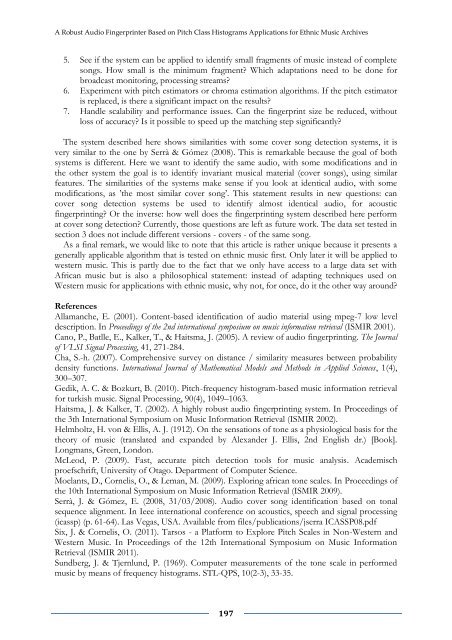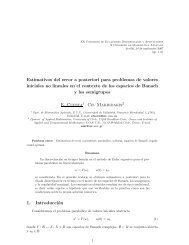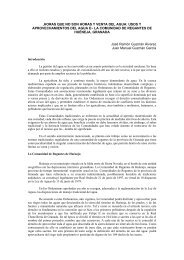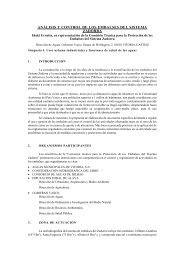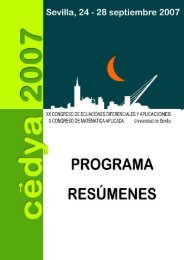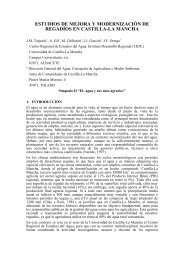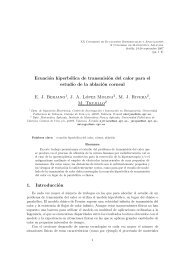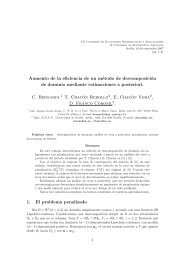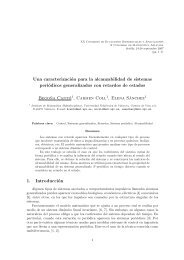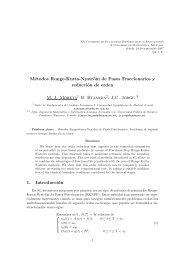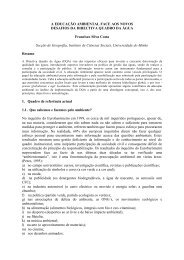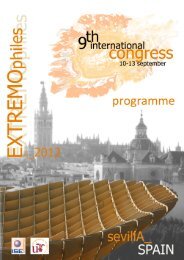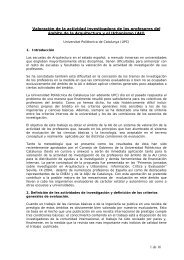LIBRO DE ACTAS (pdf) - Universidad de Sevilla
LIBRO DE ACTAS (pdf) - Universidad de Sevilla
LIBRO DE ACTAS (pdf) - Universidad de Sevilla
You also want an ePaper? Increase the reach of your titles
YUMPU automatically turns print PDFs into web optimized ePapers that Google loves.
A Robust Audio Fingerprinter Based on Pitch Class Histograms Applications for Ethnic Music Archives<br />
5. See if the system can be applied to i<strong>de</strong>ntify small fragments of music instead of complete<br />
songs. How small is the minimum fragment? Which adaptations need to be done for<br />
broadcast monitoring, processing streams?<br />
6. Experiment with pitch estimators or chroma estimation algorithms. If the pitch estimator<br />
is replaced, is there a significant impact on the results?<br />
7. Handle scalability and performance issues. Can the fingerprint size be reduced, without<br />
loss of accuracy? Is it possible to speed up the matching step significantly?<br />
The system <strong>de</strong>scribed here shows similarities with some cover song <strong>de</strong>tection systems, it is<br />
very similar to the one by Serrà & Gómez (2008). This is remarkable because the goal of both<br />
systems is different. Here we want to i<strong>de</strong>ntify the same audio, with some modifications and in<br />
the other system the goal is to i<strong>de</strong>ntify invariant musical material (cover songs), using similar<br />
features. The similarities of the systems make sense if you look at i<strong>de</strong>ntical audio, with some<br />
modifications, as ’the most similar cover song’. This statement results in new questions: can<br />
cover song <strong>de</strong>tection systems be used to i<strong>de</strong>ntify almost i<strong>de</strong>ntical audio, for acoustic<br />
fingerprinting? Or the inverse: how well does the fingerprinting system <strong>de</strong>scribed here perform<br />
at cover song <strong>de</strong>tection? Currently, those questions are left as future work. The data set tested in<br />
section 3 does not inclu<strong>de</strong> different versions - covers - of the same song.<br />
As a final remark, we would like to note that this article is rather unique because it presents a<br />
generally applicable algorithm that is tested on ethnic music first. Only later it will be applied to<br />
western music. This is partly due to the fact that we only have access to a large data set with<br />
African music but is also a philosophical statement: instead of adapting techniques used on<br />
Western music for applications with ethnic music, why not, for once, do it the other way around?<br />
References<br />
Allamanche, E. (2001). Content-based i<strong>de</strong>ntification of audio material using mpeg-7 low level<br />
<strong>de</strong>scription. In Proceedings of the 2nd international symposium on music information retrieval (ISMIR 2001).<br />
Cano, P., Batlle, E., Kalker, T., & Haitsma, J. (2005). A review of audio fingerprinting. The Journal<br />
of VLSI Signal Processing, 41, 271-284.<br />
Cha, S.-h. (2007). Comprehensive survey on distance / similarity measures between probability<br />
<strong>de</strong>nsity functions. International Journal of Mathematical Mo<strong>de</strong>ls and Methods in Applied Sciences, 1(4),<br />
300–307.<br />
Gedik, A. C. & Bozkurt, B. (2010). Pitch-frequency histogram-based music information retrieval<br />
for turkish music. Signal Processing, 90(4), 1049–1063.<br />
Haitsma, J. & Kalker, T. (2002). A highly robust audio fingerprinting system. In Proceedings of<br />
the 3th International Symposium on Music Information Retrieval (ISMIR 2002).<br />
Helmholtz, H. von & Ellis, A. J. (1912). On the sensations of tone as a physiological basis for the<br />
theory of music (translated and expan<strong>de</strong>d by Alexan<strong>de</strong>r J. Ellis, 2nd English dr.) [Book].<br />
Longmans, Green, London.<br />
McLeod, P. (2009). Fast, accurate pitch <strong>de</strong>tection tools for music analysis. Aca<strong>de</strong>misch<br />
proefschrift, University of Otago. Department of Computer Science.<br />
Moelants, D., Cornelis, O., & Leman, M. (2009). Exploring african tone scales. In Proceedings of<br />
the 10th International Symposium on Music Information Retrieval (ISMIR 2009).<br />
Serrà, J. & Gómez, E. (2008, 31/03/2008). Audio cover song i<strong>de</strong>ntification based on tonal<br />
sequence alignment. In Ieee international conference on acoustics, speech and signal processing<br />
(icassp) (p. 61-64). Las Vegas, USA. Available from files/publications/jserra ICASSP08.<strong>pdf</strong><br />
Six, J. & Cornelis, O. (2011). Tarsos - a Platform to Explore Pitch Scales in Non-Western and<br />
Western Music. In Proceedings of the 12th International Symposium on Music Information<br />
Retrieval (ISMIR 2011).<br />
Sundberg, J. & Tjernlund, P. (1969). Computer measurements of the tone scale in performed<br />
music by means of frequency histograms. STL-QPS, 10(2-3), 33-35.<br />
197


